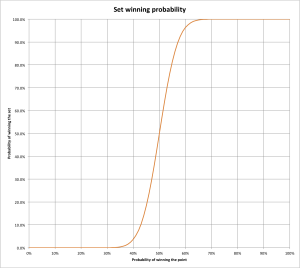In this post we are going to establish the formula for winning a set given the ability to score a point. We have already derived the formula for winning a game in another post:
We will build on that. In fact, winning a set in tennis means winning 6 or 7 games (either 6-any or 7-5) and occasionally a tiebreak (7-6). We will re-use the formula for winning a game quite often. Therefore, let us create a shortcut and call it like this:
In order to make the formulas more readable, will always refer to point winning probabilities, and
will always refer to game winning probabilities.
One can win a set by 6-0, 6-1, 6-2, 6-3, 6-4, 7-5 or 7-6. That leads to this formula:
means winning the set with 6 games to 0, 1, 2, 3 or 4 opponent games.
means winning 7-5,
means getting to 6-6, and
means winning the tiebreak.
We are going through exactly the same considerations as in this earlier post.
The first part of the above formula states the number of ways of getting to a specific result. For instance, how many ways are there of beating an opponent 6-2? In the above formula this relates to . There are
ways of getting to 6-2, because the opponent can win these 2 games anytime before, during or after the first 5 games we score ourselves (but not after the 6th game, because by then, the set would be over).As seen in a previous post, the answer is
, .
This number is then multiplied by the probability of a single way of getting to a specific result. For instance, one single way of getting to 6-2 has the probability of .
The following formulas are of a very similar pattern.
Getting to 6-6 necessarily implies getting to 5-5. The formula uses that fact by first calculating the probability of 5-5, because the first 5 games can be scored in any order (but the sixth game cannot, because it wins the set if the opponent does not already have scored 5 games). The “” part is due to the fact that after 5-5 there are two ways of getting to 6-6, i.e. 6-5/6-6 and 5-6/6-6.
The tiebreaker can be won by 7-any or by getting to 6 all and then to win from there by a two point difference.
As opposed to the above , here scoring 6 points does not mean one wins the tiebreak (but winning 6 games wins the set). Thus, the two formulas are not identical.
That last part is identical to the formula of winning a game after deuce.
Although we have all the components of the final formula, I will not put its pieces together, as it would just explode. Instead, I will show the resulting graph one more time:

